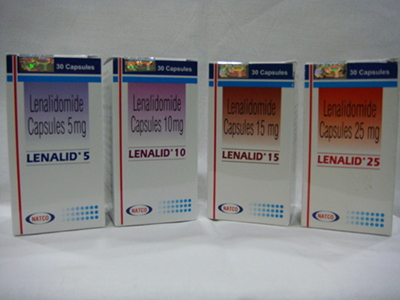
Lenalid (Lenalidomide) by Natco is a generic version of lenalidomide.
Generic Name : Lenalidomide
Brand Name: lenalid
Generic Brand Name: Lenalid
Uses For lenalidomide
Lenalidomide is used to treat anemia (low red blood cells) in patients with a certain type of myelodysplastic syndrome (MDS) called 5q MDS. Patients with this type of MDS may have very low red blood cell counts and require blood transfusions.
Lenalidomide is also used in combination with dexamathasone to treat multiple myeloma (plasma cell cancer) in patients who have received at least one prior therapy.
Once a medicine has been approved for marketing for a certain use, experience may show that it is also useful for other medical problems. Although these uses are not included in product labeling, lenalidomide is used in certain patients with the following medical condition:
Multiple myeloma, first-line treatment, in combination with dexamethasone (treatment of bone marrow cancer; used together with dexamethasone).
This information is not intended as medical advice for individual conditions or treatment. It is not a substitute for a medical exam, nor does it replace the need for services provided by medical professionals. Talk to your doctor, nurse or pharmacist before taking any prescription or over the counter drugs (including any herbal medicines or supplements) or following any treatment or regimen. Only your doctor, nurse, or pharmacist can provide you with advice on what is safe and effective for you.
Warning & Precautions
Along with its needed effects, a medicine may cause some unwanted effects. Although not all of these side effects may occur, if they do occur they may need medical attention.
Check with your doctor immediately if any of the following side effects occur:
More common
Black, tarry stools
bleeding gums
blood in the urine or stools
chest pain
chills
convulsions
cough
decreased urine
difficult or labored breathing
dry mouth
fever
increased thirst
irregular heartbeat
loss of appetite
lower back or side pain
mood changes
muscle pain or cramps
nausea or vomiting
numbness or tingling in the hands, feet, or lips
painful or difficult urination
pale skin
pinpoint red spots on the skin
shortness of breath
sore throat
sores, ulcers, or white spots on the lips or in the mouth
swollen glands
tightness in the chest
unusual bleeding or bruising
unusual tiredness or weakness
wheezing
Some side effects may occur that usually do not need medical attention. These side effects may go away during treatment as your body adjusts to the medicine. Also, your health care professional may be able to tell you about ways to prevent or reduce some of these side effects. Check with your health care professional if any of the following side effects continue or are bothersome or if you have any questions about them:
More common
Abnormal or decreased touch sensation
back pain
bloody nose
blurred vision
body aches or pain
bruising
burning while urinating
burning, numbness, tingling, or painful sensations
change in taste
constipation
contusion
cough-producing mucus
depressed mood
diarrhea
difficulty having a bowel movement (stool)
difficulty with moving
discouragement
drowsiness
dry skin and hair
dryness or soreness of the throat
ear congestion
fast, slow, irregular, pounding, or racing heartbeat or pulse
feeling sad or empty
feeling unusually cold
flushing, redness of the skin
hair loss
headache
hoarseness or husky voice
irritability
itching skin
itching, pain, redness, swelling, tenderness, or warmth on the skin
lack or loss of strength
large, flat, blue or purplish patches in the skin
loose stools
loss of appetite
loss of interest or pleasure
loss of taste
loss of voice
muscle aching
muscle spasms, stiffness, or twitching
nasal congestion
nervousness
night sweats
pain
pain in the arms or legs
pain in joints
pain or tenderness around the eyes and cheekbones
pounding in the ears
rash
runny nose
seizures
shivering
sleeplessness
sneezing
stomach pain
stuffy or runny nose
sweating increased
swelling of the hands, ankles, feet, or lower legs
swollen joints
tender, swollen glands in the neck
tiredness
trembling
trouble with concentrating
trouble with sleeping
trouble with swallowing
troubled breathing with exertion
unable to sleep
unsteadiness or awkwardness
unusually warm skin
upper abdomen or stomach pain
voice changes
vomiting
weakness in the arms, hands, legs, or feet
weight gain
weight loss
Other side effects not listed may also occur in some patients. If you notice any other effects, check with your healthcare professional.
